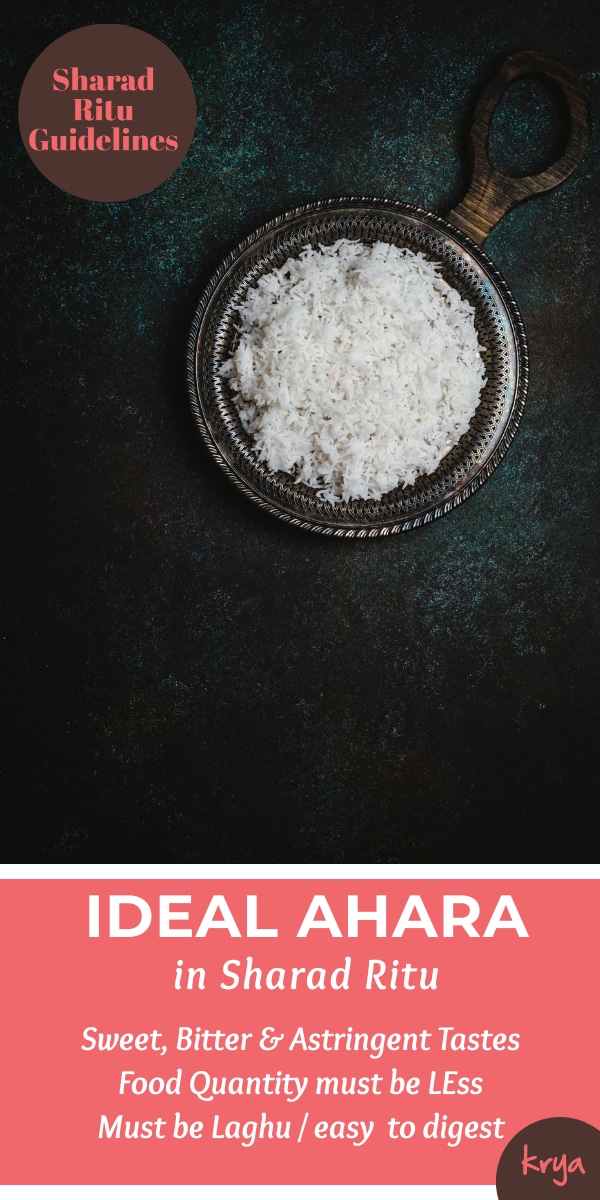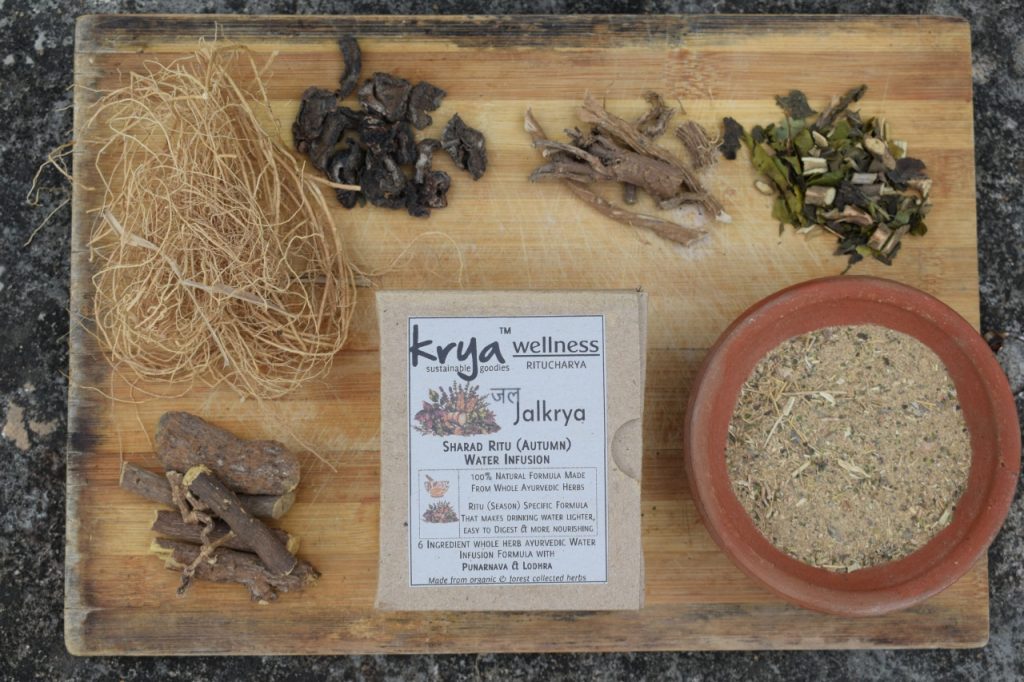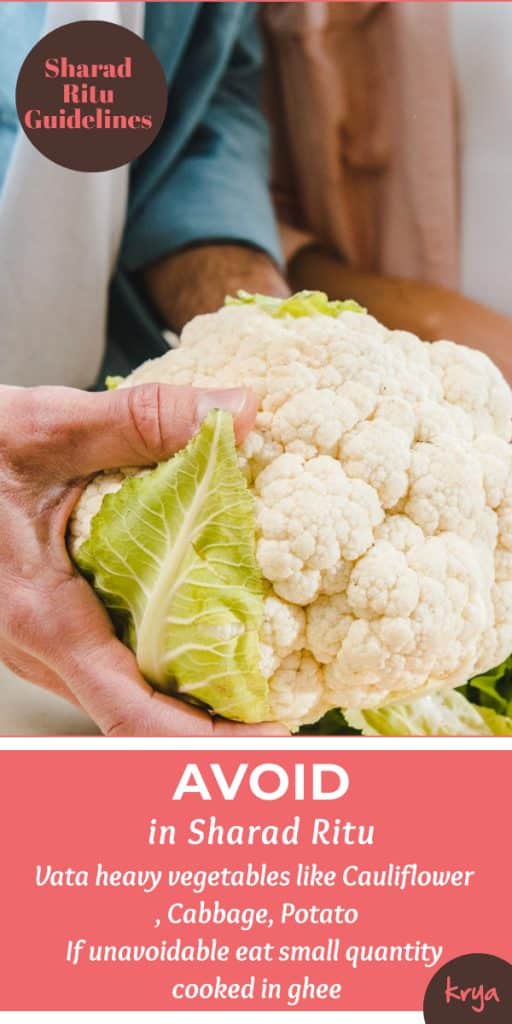This post was last updated on August 5, 2023 by Preethi Sukumaran
It is mid-September and we are at the cusp of another season, Sharad Ritu. For every season we release Ritucharya guidelines as a part of our overall work on health and wellness.
Why is it important to follow Ritucharya? Ayurveda operates from a very simple, yet fundamental precept of health in your hands. IF we follow a simple well-designed regimen that suits our prakriti (Dinacharya) and modify this regimen slightly every season to suit the seasonal ups and downs in Doshas (Ritucharya), we are able to develop our health, strength and immunity.
The Acharyas tells us that by simply following appropriate Dinacharya and Ritucharya routines we can avert about 85% of all diseases. Imagine that! That is a ton of time saved with energy for us to focus on important projects, our families and ourselves.

Ritucharya basics: Uttarayana & Dakshinayana
Ayurveda divides each year into 6 seasons of 2 months. These 6 seasons are split into 2 blocks: one that fall in Uttarayana period and the others that fall into Dakshinayana period.
In the Uttrayana period, the sun moves in a northerly direction, so the intensity of the sun is higher for those countries in the Northern hemisphere. The Sun’s rays are intense and emit a great amount of heat that dries up and evaporates moisture from the earth and all living beings in the affected parts of the Earth. As the air comes into contact with sun, it becomes dry and hot. The moisture and cooling properties of earth are taken away by Sun and the hot air. Moisture within plants, animals and human beings is reduced and body becomes weak requiring more and more water
In these seasons of Uttarayana, people become increasingly weaker and more debilitated. Therefore, this period of 6 months when the sun moves in a northern direction is called “Adana Kala” or time of reduction / lessening. The seasons of Shishira (late winter), Vasanta (spring) and Greeshma (summer) fall into this period of Adana Kala. Hence, we can see decreasing body strength as the seasons change in this period.

Dakshinayana has higher dominance of Soma or cooling energy from the Moon. This entire period is increasingly mild and cool. The sky has clouds, breeze and rains in this period. In nature, the Moon gains dominance cooling the atmosphere. The water content in plants, animals and humans increase: fruits and vegetables are juicier and increasingly sweeter.
Varsha (Monsoon), Sharad (Autumn) and Hemanta (early winter) are the 3 seasons in this period of Visarga Kala (meaning period of strengthening /increasing). With the passage of each season, our strength increases.
Therefore, in Ayurveda from Sharad Ritu onwards we can begin planning a new fitness regimen, can implement a new strength training program or can even work on our hair, skin or reproductive fitness. With the visarga kala in our favour, there is greater chance of success for us in all these enhancing programmes. In Sharad Ritu our strength is middling / moderate – it reaches a peak in Hemanta / early winter season.

Sharad Ritu features: appearance of the earth
After the rain, slush, and vata aggravation and susceptibility to disease that we experience in Varsha (monsoon) ritu, Sharad Ritu sees a clearing up of the earth and skies.
The Acharyas describe Sharad Ritu as the season where the skies are clear without clouds. There is a new growth of water seeking plants like lilies, Kasa grass, paddy, etc. As the sky is clear and cloudless, the sun rays are hot, wide and far reaching. However, unlike Greeshma Ritu, the air is not dry and moisture less.
Fishes and other aquatic organisms become active, so lakes and ponds have undulating appearance from the brisk movement of these small beings. The water in ponds and water bodies appears clear, and not muddy or slushy as we observed in Varsha Ritu.

Sharad Ritu features: Dosha changes we can expect in the body
In each season we see chaya (mild accumulation), prakopa (high aggravation) and prashamana (natural balance) of one or the other dosha. Depending upon which Pancha mahabootha attains prominence, we can see a corresponding change in our body as well.
In Sharad Ritu, vata dosha which was in prakopa (aggravation) in Varsha will come to natural balance (if Ritucharya was followed). Pitta dosha which was in chaaya (mild accumulation) in Varsha attains prakopa (aggravation).
So, in Sharad ritu, we have an aggravation of Pitta dosha. This is because Pitta dosha which was accumulating in the previous season, gets further increased as Sun’s intensity increases (due to lack of cloud cover).

Ahara Modifications needed for Sharad Ritu
Pitta dosha is the dosha which regulates digestion, skin colour, black colour of hair, focus, eye sight and plays a large part in developing “medhya” or intelligence. Pitta dosha also regulates the formation of good quality blood / rakta Dhatu. But for all of these functions, Pitta has to be in the RIGHT quantity.
Like an unchecked forest fire, when Pitta dosha is teekshna / intensive and very aggravated, it burns / chars without proper digestion. So, in states of aggravated pitta dosha we often develop diarrhoea, ulcers, acidity without proper nutritional absorption.
Also, Pitta dosha is a combination of 2 Pancha mahaboothas: Agni and Jala (fire and water). This gives Pitta both its fiery nature and also its Drava and Snigdha guna (watery + oily nature). So, in this season of Sharad, we see a corresponding increase in both arts of Pitta Dosha, Agni and Jala.
This combination of fiery Agni + extra water combines to douse digestion, increase bloating and reduce appetite.

So, the Diet plan for Sharad Ritu must take into account the excess water in system, the suppressed appetite and poorer ability to digest and process food. The Diet plan must also help balance BOTH aspects of the enhanced Pitta dosha which we see in this season.
Recommended Ahara Changes for Sharad Ritu:
To cope with supressed digestion and excess water in the body, the food that we eat must be easy to digest and light. We must also eat in lesser quantity than usual. Next, the tastes must balance both parts of Pitta. So, all Ahara must have predominantly madhura, tikta and Kashaya (sweet, astringent and bitter) tastes.
Examples of balanced Ahara for Sharad Ritu:
- Grain: Wheat, Rice and Barley – Rice must be white, and short duration or Shastika rice – brown rice, etc is not suitable
- Barley is sweet + diuretic – so it is a good combination in this season when water + Agni are high due to pitta aggravation
- Lentils: Green gram is ideal in this season. Tuvar can be used sparingly. We must cut down on Channa, rajma, urad, etc in this season
- Sweet bitter and astringent vegetables are suggested: Parwal / Pointed gourd, bottle gourd, bitter gourd, ash gourd is recommended strongly as they are sweet and slightly tikta / bitter
- One can have small amount of bitters like bitter gourd, methi, etc
- Vegetables like Yam (suran), young radish, etc can be had. Carrot, beetroot etc in moderate quantities can be had
- Heavy to digest vegetables like potato, etc should be cut down
- Gas producing vegetables like broccoli, cauliflower, cabbage should be reduced – and must be cooked well with ghee
Pana / Drinks:
- Water must be drunk after vigorous roll boiling & shrinking in this season to adjust to teh excess water in the system
- Water must be ideally shrunk to 75% of its original volume in this season and boiled with Pitta reducing, madhura, kashaya and tikta rasa herbs like Punarnava, Lodhra, Amla, Usheera,etc
The Krya Jal Krya-Sharad Ritu variant is an ideal water supplement for this season. This contains the correct mixture of herbs that is recommended to be boiled along with water in this season. You can read more about the product and how to use it here.

JalKrya – Herb Mix for Drinking Water for Sharad Ritu (Autumn) – 50 gm
Meat:
- Dry, lean meat is suggested like rabbit, quail, partridge etc
- For an urban dweller lean mutton, or native hen is suggested
- High fat meat like broiler chicken, pork, etc is to be avoided in this season
- Meat is suggested for those with good appetite or hunger – if your appetite is poor, eat less frequently
Special Foods and drinks suggested
- Bitter medicated ghees
- Honey
- Draksha / raisin
- Amla
- Slightly cool and easy to digest foods and drinks

Hamsodaka: special feature of Sharad Ritu
In Sharad Ritu, we have the effect of the Agastya constellation which is present for roughly 1.5 months of the ritu. The rays of this star constellation are supposed to make water more medicinal and better to drink.
Water which has been exposed to the sun rays of Sharad Ritu, Moon Rays and the rays of Agastya constellation at night develops good medicinal properties. This water is referred to as Hamsodaka or water that clear and good like the Hamsa / Swan’s capacity to separate water and milk. Agastya constellation began to rise in mid-August – so we can expect to have this effect until mid-October.
How to make Hamsodaka:
Keep water in a stainless-steel container (covered) in afternoon sunshine. Then let it sit on a safe spot in your terrace / balcony where it is further exposed to moon rays and Agastya constellation reflect light, overnight. Next morning, boil this Hamsodaka water with ritu appropriate herbs to render it appropriate + healing for this season.
Hamsodaka water can also be used to bathe in, as anupana for your Face and Hair Lepas, to mix your hair and skin products, etc. Swimming in Hamsodaka is also a recommended Sharad ritu activity – so if you can find a relatively clean outdoor pool to swim in this season, it would be beneficial (as the water is exposed to sun, Moon and Agastya constellation.
Regimen to be followed for Sharad Ritu
In this Ritu, the focus is on controlling Pitta through relaxation, fragrances and water-based activities, using Pitta balancing scents, and fragrances. So, the acharyas tell us to sail in beautiful lakes, watch swans swim in water bodies, or spend time near ponds / water bodies with bees, lotus flowers and lily flowers.
We are asked to wear light, pastel shades and not very bright pitta promoting colours like dark reds, fiery oranges, etc. We are asked to wear fragrant seasonal flowers as garlands or in the hair as Pitta calms down with good fragrances, and pleasing hedonistic textures and experiences. We are also asked to preferentially use Pitta calming herbs in our hair and skin products like Vetiver, Chandana, Agaru, Rose, Patranga, Mushta, etc.
A special daily activity suggested in Sharad Ritu is to spend the late evenings absorbing the moon rays, in a moonlit terrace preferably. We should not spend late nights in this atmosphere as it can severely aggravate Kapha dosha and seasonal allergies. Spending time between 5:30 pm up to 8 pm is ideal.

Seasonal Guidelines for each Ritu
If you enjoyed reading this, here are the Ritucharya guidelines for the other seasons:
- Hemanta Ritucharya (Early Winter seasonal living guidelines)
- Vasanta Ritucharya (Spring Seasonal living guidelines)
- Greeshma Ritucharya (Summer seasonal living guidelines)
- Varsha Ritucharya (Monsoon seasonal living guidelines)
To Sum up:
In the first part of our Sharad Ritu guidelines we explored the reason behind following Ritucharya and how it benefits our health and wellbeing. We then explored the change in weather and climatic patterns between Monsoon and Autumn. We then looked at the change in the importance of the Pancha mahaboothas and understood how Pitta aggravates in this season, differently from Summer. We then looked at Ahara guidelines and certain Regimen suggestions for Sharad Ritu.
What are the foods and activities we must not do / indulge in? How must we control our intellectual activities? Are there any mental health checks we must make in this season? What Krya products are suitable in Sharad Ritu? For this and more, please wait for Part 2 of this post.






Where can be read part 2?
Shld we do abhyanga in sharad ritu?
Bhawna, absolutely yes. Abhyanga is recommended throughout the year, and should only be done sparingly in Greeshma ritu.